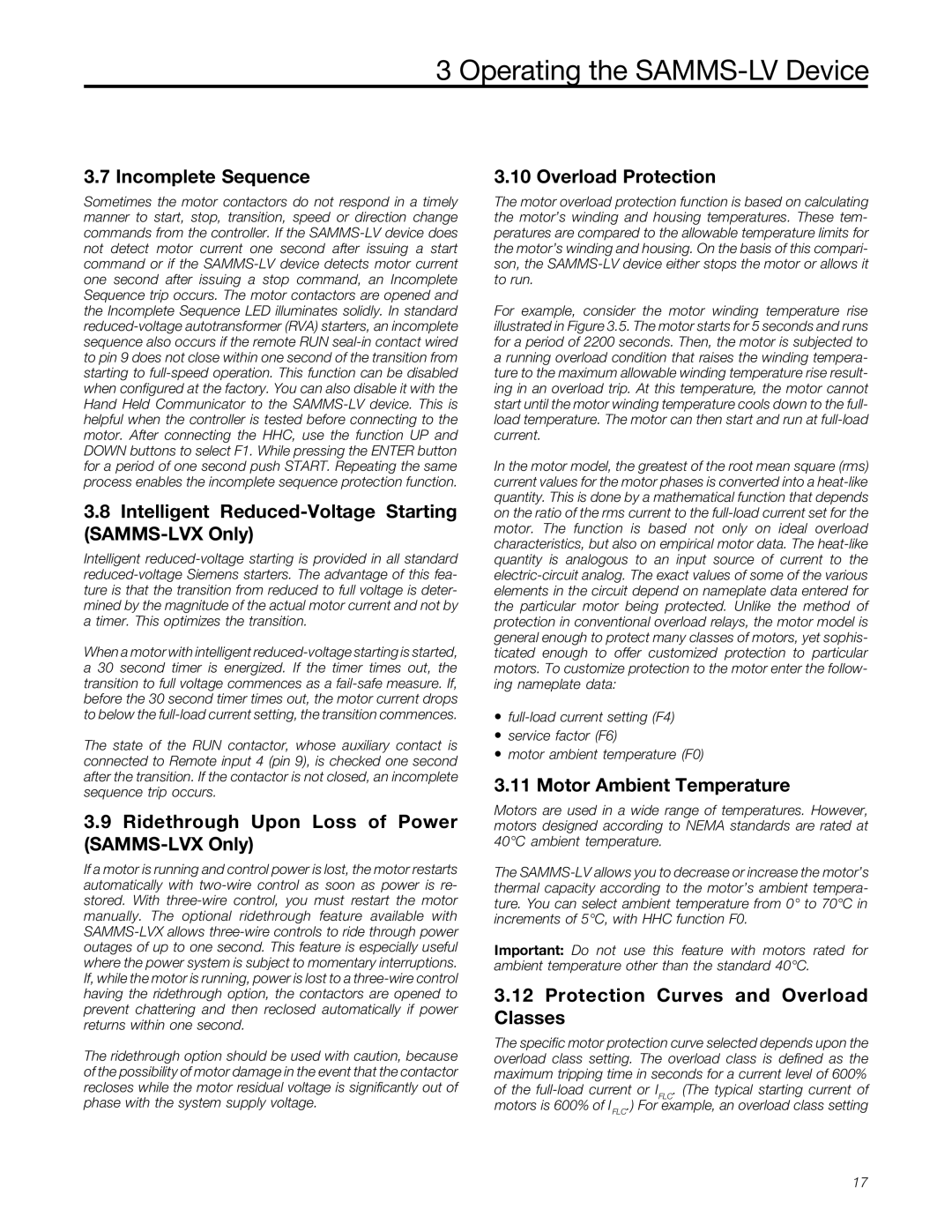3.7 Incomplete Sequence
Sometimes the motor contactors do not respond in a timely manner to start, stop, transition, speed or direction change commands from the controller. If the SAMMS-LV device does not detect motor current one second after issuing a start command or if the SAMMS-LV device detects motor current one second after issuing a stop command, an Incomplete Sequence trip occurs. The motor contactors are opened and the Incomplete Sequence LED illuminates solidly. In standard reduced-voltage autotransformer (RVA) starters, an incomplete sequence also occurs if the remote RUN seal-in contact wired to pin 9 does not close within one second of the transition from starting to full-speed operation. This function can be disabled when configured at the factory. You can also disable it with the Hand Held Communicator to the SAMMS-LV device. This is helpful when the controller is tested before connecting to the motor. After connecting the HHC, use the function UP and DOWN buttons to select F1. While pressing the ENTER button for a period of one second push START. Repeating the same process enables the incomplete sequence protection function.
3.8Intelligent Reduced-Voltage Starting (SAMMS-LVX Only)
Intelligent reduced-voltage starting is provided in all standard reduced-voltage Siemens starters. The advantage of this fea- ture is that the transition from reduced to full voltage is deter- mined by the magnitude of the actual motor current and not by a timer. This optimizes the transition.
When a motor with intelligent reduced-voltage starting is started, a 30 second timer is energized. If the timer times out, the transition to full voltage commences as a fail-safe measure. If, before the 30 second timer times out, the motor current drops to below the full-load current setting, the transition commences.
The state of the RUN contactor, whose auxiliary contact is connected to Remote input 4 (pin 9), is checked one second after the transition. If the contactor is not closed, an incomplete sequence trip occurs.
3.9Ridethrough Upon Loss of Power (SAMMS-LVX Only)
If a motor is running and control power is lost, the motor restarts automatically with two-wire control as soon as power is re- stored. With three-wire control, you must restart the motor manually. The optional ridethrough feature available with SAMMS-LVX allows three-wire controls to ride through power outages of up to one second. This feature is especially useful where the power system is subject to momentary interruptions. If, while the motor is running, power is lost to a three-wire control having the ridethrough option, the contactors are opened to prevent chattering and then reclosed automatically if power returns within one second.
The ridethrough option should be used with caution, because of the possibility of motor damage in the event that the contactor recloses while the motor residual voltage is significantly out of phase with the system supply voltage.
3.10 Overload Protection
The motor overload protection function is based on calculating the motor’s winding and housing temperatures. These tem- peratures are compared to the allowable temperature limits for the motor’s winding and housing. On the basis of this compari- son, the SAMMS-LV device either stops the motor or allows it to run.
For example, consider the motor winding temperature rise illustrated in Figure 3.5. The motor starts for 5 seconds and runs for a period of 2200 seconds. Then, the motor is subjected to a running overload condition that raises the winding tempera- ture to the maximum allowable winding temperature rise result- ing in an overload trip. At this temperature, the motor cannot start until the motor winding temperature cools down to the full- load temperature. The motor can then start and run at full-load current.
In the motor model, the greatest of the root mean square (rms) current values for the motor phases is converted into a heat-like quantity. This is done by a mathematical function that depends on the ratio of the rms current to the full-load current set for the motor. The function is based not only on ideal overload characteristics, but also on empirical motor data. The heat-like quantity is analogous to an input source of current to the electric-circuit analog. The exact values of some of the various elements in the circuit depend on nameplate data entered for the particular motor being protected. Unlike the method of protection in conventional overload relays, the motor model is general enough to protect many classes of motors, yet sophis- ticated enough to offer customized protection to particular motors. To customize protection to the motor enter the follow- ing nameplate data:
∙full-load current setting (F4)
∙service factor (F6)
∙motor ambient temperature (F0)
3.11 Motor Ambient Temperature
Motors are used in a wide range of temperatures. However, motors designed according to NEMA standards are rated at 40°C ambient temperature.
The SAMMS-LV allows you to decrease or increase the motor’s thermal capacity according to the motor’s ambient tempera- ture. You can select ambient temperature from 0° to 70°C in increments of 5°C, with HHC function F0.
Important: Do not use this feature with motors rated for ambient temperature other than the standard 40°C.
3.12Protection Curves and Overload Classes
The specific motor protection curve selected depends upon the overload class setting. The overload class is defined as the maximum tripping time in seconds for a current level of 600% of the full-load current or IFLC. (The typical starting current of motors is 600% of IFLC.) For example, an overload class setting
